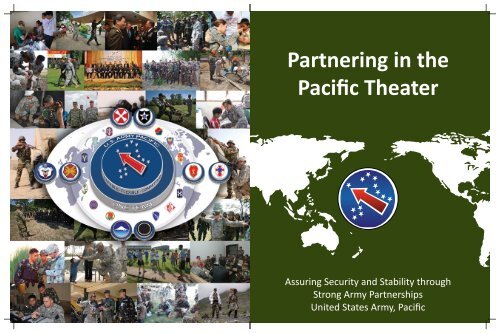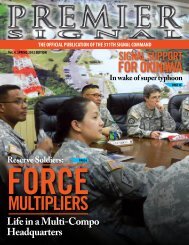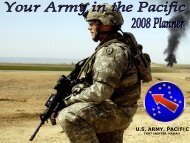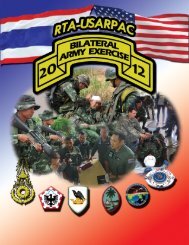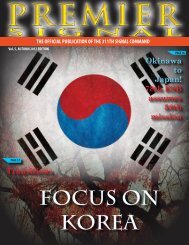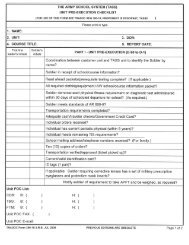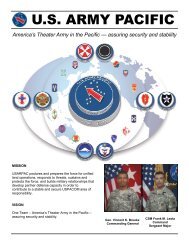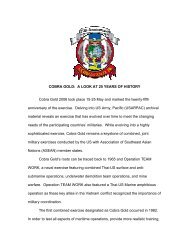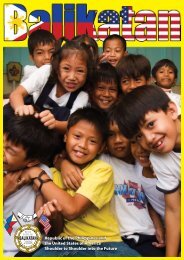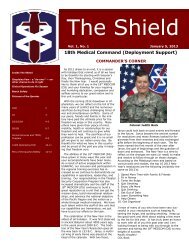Assuring security and stability through strong Army ... - USARPAC
Assuring security and stability through strong Army ... - USARPAC
Assuring security and stability through strong Army ... - USARPAC
Create successful ePaper yourself
Turn your PDF publications into a flip-book with our unique Google optimized e-Paper software.
Partnering in the<br />
<br />
<<strong>strong</strong>>Assuring</<strong>strong</strong>> Security <<strong>strong</strong>>and</<strong>strong</strong>> Stability <<strong>strong</strong>>through</<strong>strong</strong>><br />
Strong <strong>Army</strong> Partnerships
the agreements necessary to train <<strong>strong</strong>>and</<strong>strong</strong>> safeguard our troops. The <strong>USARPAC</strong> exercise <<strong>strong</strong>>and</<strong>strong</strong>> engagement<br />
program, with partnership exercises from Mongolia to New Zeal<<strong>strong</strong>>and</<strong>strong</strong>> to India, provides the ideal training<br />
grounds for the current generation of Soldiers, who joined the <strong>Army</strong> to deploy <<strong>strong</strong>>and</<strong>strong</strong>> train with our<br />
international partners.<br />
The “Engage <<strong>strong</strong>>and</<strong>strong</strong>> Partner” line of effort is critical to achieving the PACOM Comm<<strong>strong</strong>>and</<strong>strong</strong>>er’s theater<br />
campaign plan objectives. <strong>USARPAC</strong>’s theater engagement concept incorporates training <<strong>strong</strong>>and</<strong>strong</strong>> exercising<br />
as a Joint Task Force (JTF) <<strong>strong</strong>>and</<strong>strong</strong>> theater Joint/Combined L<<strong>strong</strong>>and</<strong>strong</strong>> Force Component Comm<<strong>strong</strong>>and</<strong>strong</strong>> (J/CFLCC)<br />
with partner nations. These training events reinforce our alliance commitments <<strong>strong</strong>>and</<strong>strong</strong>> impart new partners<br />
with the capability <<strong>strong</strong>>and</<strong>strong</strong>> capacity to act <<strong>strong</strong>>and</<strong>strong</strong>> respond together in a coalition. Whether it is enabling<br />
PACOM training <<strong>strong</strong>>and</<strong>strong</strong>> contingency access, developing partner disaster resiliency, or forming an<br />
operational JTF or CFLCC mission comm<<strong>strong</strong>>and</<strong>strong</strong>> capability, <strong>USARPAC</strong>’s engagement effort is both relevant<br />
<<strong>strong</strong>>and</<strong>strong</strong>> essential to achieving success.<br />
Winning the nation’s wars has <<strong>strong</strong>>and</<strong>strong</strong>> will always be the U.S. <strong>Army</strong>’s most essential mission. The <strong>Army</strong>’s<br />
ability to win in any environment, with the flexibility <<strong>strong</strong>>and</<strong>strong</strong>> depth to overcome any adversity, has been its<br />
hallmark for over 237 years. Yet, in the complex globalized <<strong>strong</strong>>security</<strong>strong</strong>> environment facing the <strong>Army</strong> of<br />
2020, preventing costly wars will be as important a measure of the <strong>Army</strong>’s success, as it was in Europe<br />
during the Cold War. The Theater <strong>Army</strong> Comm<<strong>strong</strong>>and</<strong>strong</strong>>er’s “Engage <<strong>strong</strong>>and</<strong>strong</strong>> Partner” line of effort <<strong>strong</strong>>and</<strong>strong</strong>> focus on<br />
the human domain is essential to prevent <<strong>strong</strong>>and</<strong>strong</strong>> deter aggression <<strong>strong</strong>>and</<strong>strong</strong>> set the conditions to win. Engaging the<br />
theater then becomes the <strong>USARPAC</strong> Comm<<strong>strong</strong>>and</<strong>strong</strong>>er’s most critical strategic task <<strong>strong</strong>>and</<strong>strong</strong>> the foundation for the<br />
theater army strategy. <strong>USARPAC</strong> is the decisive theater l<<strong>strong</strong>>and</<strong>strong</strong>> force, with the flexibility <<strong>strong</strong>>and</<strong>strong</strong>> sustainability,<br />
to accomplish the task <<strong>strong</strong>>and</<strong>strong</strong>> realize the PACOM Comm<<strong>strong</strong>>and</<strong>strong</strong>>er’s vision for the theater. <strong>USARPAC</strong>’s <strong>strong</strong><br />
<strong>Army</strong> partnerships across the theater develop the trust <<strong>strong</strong>>and</<strong>strong</strong>> confidence necessary to form <<strong>strong</strong>>and</<strong>strong</strong>> foster<br />
participation in multinational, l<<strong>strong</strong>>and</<strong>strong</strong>>-force coalitions that will respond to the future crises <<strong>strong</strong>>and</<strong>strong</strong>> contingencies<br />
that lie ahead. For the U.S. <strong>Army</strong> Pacific of 2020, – by, with, or <<strong>strong</strong>>through</<strong>strong</strong>> our allies <<strong>strong</strong>>and</<strong>strong</strong>> partners – it is the<br />
best way to ensure peace <<strong>strong</strong>>and</<strong>strong</strong>> <<strong>strong</strong>>security</<strong>strong</strong>> in the Asia Pacific.<br />
PREPARED BY THE <strong>USARPAC</strong> STAFF: POCs are COL James O. Robinson Jr. at<br />
james.o.robinson.mil@mail.mil <<strong>strong</strong>>and</<strong>strong</strong>> LTC John C. Lee at john.c.lee.mil@mail.mil.<br />
11
Partnering in the Asia-Pacific Theater<br />
The U.S. <strong>Army</strong>, Pacific’s Theater Engagement Strategy White Paper<br />
Our relationships with Asian allies <<strong>strong</strong>>and</<strong>strong</strong>> key partners are critical to the future <<strong>strong</strong>>stability</<strong>strong</strong>> <<strong>strong</strong>>and</<strong>strong</strong>> growth of the<br />
region. We will emphasize our existing alliances, which provide a vital foundation for Asia-Pacific<br />
<<strong>strong</strong>>security</<strong>strong</strong>>. We will also exp<<strong>strong</strong>>and</<strong>strong</strong>> our networks of cooperation with emerging partners <<strong>strong</strong>>through</<strong>strong</strong>>out the Asia-<br />
Pacific to ensure collective capability <<strong>strong</strong>>and</<strong>strong</strong>> capacity for securing the common interest.<br />
Executive Summary<br />
1<br />
- Honorable Leon Panetta<br />
Secretary of Defense<br />
The United States <strong>Army</strong> has an enduring historic legacy in the Asia-Pacific fighting 63 campaigns since<br />
1899—more than any other geographical region outside of the Americas. This legacy continues today<br />
with the U.S. <strong>Army</strong>, Pacific (<strong>USARPAC</strong>) as the decisive l<<strong>strong</strong>>and</<strong>strong</strong>> force with the depth <<strong>strong</strong>>and</<strong>strong</strong>> sustainability to:<br />
1) prevent conflicts first <<strong>strong</strong>>and</<strong>strong</strong>> foremost, 2) promote the conditions necessary to maintain peace <<strong>strong</strong>>and</<strong>strong</strong>><br />
<<strong>strong</strong>>stability</<strong>strong</strong>>, <<strong>strong</strong>>and</<strong>strong</strong>> 3) prevail in conflicts when all other courses of action are exhausted in the Asia-Pacific. To<br />
contribute to this renewed Asia-Pacific focus expressed by President Obama <<strong>strong</strong>>and</<strong>strong</strong>> Secretary Panetta,<br />
<strong>USARPAC</strong>’s theater strategy operationalizes four core tenets: persistent engagement, forward presence,<br />
trained <<strong>strong</strong>>and</<strong>strong</strong>> ready forces, <<strong>strong</strong>>and</<strong>strong</strong>> agile mission comm<<strong>strong</strong>>and</<strong>strong</strong>>. Working in concert, these four tenets enable the<br />
<strong>USARPAC</strong> Comm<<strong>strong</strong>>and</<strong>strong</strong>>er to engage the theater to prevent in<<strong>strong</strong>>stability</<strong>strong</strong>> <<strong>strong</strong>>and</<strong>strong</strong>> set the conditions to rapidly<br />
respond to a full spectrum of contingencies <<strong>strong</strong>>and</<strong>strong</strong>> to win in combat—if necessary. Engaging the theater <<strong>strong</strong>>and</<strong>strong</strong>><br />
working alongside partners is <strong>USARPAC</strong>’s first line of effort in a theater campaign support plan designed<br />
to enable the comm<<strong>strong</strong>>and</<strong>strong</strong>>—by, with, or <<strong>strong</strong>>through</<strong>strong</strong>> allies <<strong>strong</strong>>and</<strong>strong</strong>> partners—to deter aggression, build capacity,<br />
<<strong>strong</strong>>and</<strong>strong</strong>> assure USPACOM success.<br />
America’s strategic focus on the region includes a <strong>strong</strong> emphasis on cooperative multilateral<br />
engagement. In this spirit of multilateralism, <strong>USARPAC</strong> consults closely with allies <<strong>strong</strong>>and</<strong>strong</strong>> partners to<br />
develop combined training concepts with willing countries, discussing regional Humanitarian Assistance<br />
<<strong>strong</strong>>and</<strong>strong</strong>> Disaster Response (HA/DR) support facilities in South <<strong>strong</strong>>and</<strong>strong</strong>> Southeast Asia, <<strong>strong</strong>>and</<strong>strong</strong>> promoting aspiring<br />
regional contributors to become net <<strong>strong</strong>>security</<strong>strong</strong>> exporters in their respective regions <<strong>strong</strong>>and</<strong>strong</strong>> globally where<br />
appropriate. Once fully developed, <strong>USARPAC</strong>’s network of cooperation will not only improve our own<br />
<<strong>strong</strong>>and</<strong>strong</strong>> our partners’ military readiness, it will also enable a cooperative strategic environment that limits<br />
harmful military influences <<strong>strong</strong>>and</<strong>strong</strong>> negates potential threats to regional peace—an interest shared by all.<br />
Ultimately, <strong>USARPAC</strong>’s <strong>strong</strong> <<strong>strong</strong>>and</<strong>strong</strong>> enduring partnerships allow the U.S. <strong>Army</strong> to foster <<strong>strong</strong>>and</<strong>strong</strong>> lead<br />
adaptable, multinational coalitions to prevent, mitigate, <<strong>strong</strong>>and</<strong>strong</strong>> respond to crises, <<strong>strong</strong>>and</<strong>strong</strong>> win in conflicts across<br />
the Asia-Pacific—when necessary. <strong>USARPAC</strong> envisions working closely within a community of interest<br />
of joint, interagency, intergovernmental <<strong>strong</strong>>and</<strong>strong</strong>> multilateral allies <<strong>strong</strong>>and</<strong>strong</strong>> partners. In this holistic approach,<br />
<strong>USARPAC</strong> seeks <<strong>strong</strong>>and</<strong>strong</strong>> welcomes input <<strong>strong</strong>>and</<strong>strong</strong>> initiatives from the multitude of joint, interagency,<br />
intergovernmental, <<strong>strong</strong>>and</<strong>strong</strong>> multinational organizations to develop a synchronized <<strong>strong</strong>>and</<strong>strong</strong>> synergistic framework<br />
to build partnerships for a lasting, secure <<strong>strong</strong>>and</<strong>strong</strong>> stable Asia-Pacific.<br />
The purpose of this white paper is to share <strong>USARPAC</strong>’s vision <<strong>strong</strong>>and</<strong>strong</strong>> design for contributing to the efforts<br />
of the United States <<strong>strong</strong>>and</<strong>strong</strong>> our allies <<strong>strong</strong>>and</<strong>strong</strong>> partners to attain peace <<strong>strong</strong>>and</<strong>strong</strong>> <<strong>strong</strong>>security</<strong>strong</strong>> in the Asia-Pacific. While<br />
joint, interagency, intergovernmental <<strong>strong</strong>>and</<strong>strong</strong>> multinational participants all bring various types <<strong>strong</strong>>and</<strong>strong</strong>> levels of<br />
Sustain Traditional Relationships.<br />
<strong>USARPAC</strong> seeks to sustain positive relationships with long st<<strong>strong</strong>>and</<strong>strong</strong>>ing friends. In a resource-constrained<br />
environment, <strong>USARPAC</strong> will work alongside these countries in broader multilateral engagements in<br />
partnerships with joint, interagency, intergovernmental, <<strong>strong</strong>>and</<strong>strong</strong>> multinational organizations while seeking to<br />
reallocate resources gained from improved capabilities with assure, promote <<strong>strong</strong>>and</<strong>strong</strong>> enhance countries to<br />
meet common <<strong>strong</strong>>security</<strong>strong</strong>> challenges. <strong>USARPAC</strong> developed the following theater campaign support<br />
objective for sustain countries:<br />
Campaign Objective: <strong>USARPAC</strong> sustains positive <strong>Army</strong> relationships <<strong>strong</strong>>and</<strong>strong</strong>> access in those Asia-<br />
Pacific countries with limited capacity to contribute to regional <<strong>strong</strong>>security</<strong>strong</strong>>.<br />
Operationally, this translates into the following operational/tactical capability related effects:<br />
<br />
<br />
<br />
<br />
Maintain essential senior level engagements<br />
U.S. <strong>Army</strong> support for regional HA/DR initiatives<br />
Increase in individual participation in PME <<strong>strong</strong>>and</<strong>strong</strong>> <<strong>strong</strong>>security</<strong>strong</strong>> force exchanges<br />
Opportunities for multilateral information exchanges<br />
V. Assessing the Engaging <<strong>strong</strong>>and</<strong>strong</strong>> Partnering.<br />
In the past, <<strong>strong</strong>>security</<strong>strong</strong>> cooperation planners used a “more is better” philosophy to theater engagement<br />
programs <<strong>strong</strong>>and</<strong>strong</strong>> relied heavily on quantitative measures—e.g. the number of engagement activities—to<br />
measure the program’s effectiveness. As the <strong>Army</strong> adjusts to a new era in fiscal discipline, planners must<br />
replace quantitative with qualitative measures that provide the comm<<strong>strong</strong>>and</<strong>strong</strong>>er the fidelity necessary to reprioritize<br />
activities <<strong>strong</strong>>and</<strong>strong</strong>> re-allocate limited resources. <strong>USARPAC</strong>’s Theater Campaign Support Plan uses<br />
the S.M.A.R.T. criteria—specific, measurable, attainable, relevant, <<strong>strong</strong>>and</<strong>strong</strong>> time-bound—to set campaign<br />
support objectives <<strong>strong</strong>>and</<strong>strong</strong>> provide the Comm<<strong>strong</strong>>and</<strong>strong</strong>>er with periodic progress reports for each line of effort.<br />
<strong>USARPAC</strong> incorporated a doctrinal working group to provide a staff-wide venue to establish <<strong>strong</strong>>and</<strong>strong</strong>> assess<br />
theater campaign support plan objectives for each line of effort. Measuring campaign progress is both an<br />
objective “science,” <<strong>strong</strong>>and</<strong>strong</strong>> a subjective “art.” <strong>USARPAC</strong>’s assessment methodology tries to balance these<br />
two approaches to give the Comm<<strong>strong</strong>>and</<strong>strong</strong>>er <<strong>strong</strong>>and</<strong>strong</strong>> his staff the necessary fidelity to make the right decision at<br />
the right time.<br />
Key to providing the <strong>USARPAC</strong> Comm<<strong>strong</strong>>and</<strong>strong</strong>>er with appropriate fidelity is input from other U.S.<br />
government, intergovernmental <<strong>strong</strong>>and</<strong>strong</strong>> multinational agencies. The <strong>USARPAC</strong> staff depends greatly on the<br />
comments <<strong>strong</strong>>and</<strong>strong</strong>> perspectives of USPACOM, Department of State, the Office of the Secretary of Defense,<br />
<<strong>strong</strong>>and</<strong>strong</strong>> embassy country teams. Additionally, <<strong>strong</strong>>through</<strong>strong</strong>> persistent engagement, <strong>USARPAC</strong> senior leaders <<strong>strong</strong>>and</<strong>strong</strong>><br />
staff gain helpful feedback from allies <<strong>strong</strong>>and</<strong>strong</strong>> partners. This input is vital to ensuring <strong>USARPAC</strong> is<br />
improving <<strong>strong</strong>>and</<strong>strong</strong>> moving relationships substantively forward <<strong>strong</strong>>and</<strong>strong</strong>> greatly augments quantitative aspects of<br />
assessments.<br />
VI.<br />
Conclusion: Engagement as a Core Theater <strong>Army</strong> Function.<br />
Preventing <<strong>strong</strong>>and</<strong>strong</strong>> deterring future conflict relies on finding the right theater force posture. The “Engage <<strong>strong</strong>>and</<strong>strong</strong>><br />
Partner” line of effort is crucial to enabling future force posture initiatives. As the U.S. <strong>Army</strong> rebalances<br />
globally <<strong>strong</strong>>and</<strong>strong</strong>> determines the optimal mix of rotational general-purpose forces <<strong>strong</strong>>and</<strong>strong</strong>> forward-deployed<br />
forces, <strong>USARPAC</strong>’s engagement efforts will set the conditions for the U.S. <strong>Army</strong> to prepare <<strong>strong</strong>>and</<strong>strong</strong>> posture<br />
for regional contingencies, creating goodwill <<strong>strong</strong>>and</<strong>strong</strong>> rapport with our regional army partners <<strong>strong</strong>>and</<strong>strong</strong>> establishing<br />
10
subject matter expert exchanges, such as: medical, engineering, peacekeeping, disaster response, <<strong>strong</strong>>and</<strong>strong</strong>> rule<br />
of law. This translates specifically into achieving the following effects:<br />
Strategic Effects<br />
<br />
<br />
<br />
Shared language <<strong>strong</strong>>and</<strong>strong</strong>> government support for partnership commitments<br />
Increased confidence <<strong>strong</strong>>and</<strong>strong</strong>> public support for PKO <<strong>strong</strong>>and</<strong>strong</strong>> HA/DR capabilities<br />
Assured USPACOM operational <<strong>strong</strong>>and</<strong>strong</strong>> training access<br />
Operational/Tactical Capability Related Effects<br />
<br />
<br />
<br />
<br />
<br />
Ability to control borders <<strong>strong</strong>>and</<strong>strong</strong>> deny VEOs operating space<br />
Increased Officer <<strong>strong</strong>>and</<strong>strong</strong>> Non-Commissioned Officer Professionalism<br />
Capacity to participate in small scale multinational PKO or HA/DR operations <<strong>strong</strong>>and</<strong>strong</strong>> training<br />
events<br />
Increased information sharing<br />
Routine <<strong>strong</strong>>and</<strong>strong</strong>> frequent senior level dialogues<br />
Open New Relationships.<br />
In the open category of countries, legislative <<strong>strong</strong>>and</<strong>strong</strong>> policy constraints on defense relationships with these<br />
countries limit <strong>USARPAC</strong>’s ability to directly engage them. Engagement activities with these countries<br />
must be vetted <<strong>strong</strong>>and</<strong>strong</strong>> approved by PACOM <<strong>strong</strong>>and</<strong>strong</strong>> OSD for policy compliance <<strong>strong</strong>>and</<strong>strong</strong>> are often subject to<br />
political dynamics outside of <strong>USARPAC</strong>’s control. The countries themselves may have a policy to limit<br />
engagements with the U.S. military as a reflection of the state of the overall bilateral relationship. All of<br />
these factors limit <strong>USARPAC</strong>’s engagement activities to senior level counterpart visits, medical,<br />
engineer, <<strong>strong</strong>>and</<strong>strong</strong>> HA/DR related exchanges—when allowed <<strong>strong</strong>>and</<strong>strong</strong>> where appropriate. However, <strong>USARPAC</strong><br />
believes these countries hold the greatest potential for opportunity over the next decade <<strong>strong</strong>>and</<strong>strong</strong>> are critical<br />
keys to achievement of our over-arching goals to prevent conflict <<strong>strong</strong>>and</<strong>strong</strong>> maintain regional peace.<br />
<strong>USARPAC</strong> continues to seek to open the lines of communication with these countries. <strong>USARPAC</strong><br />
developed the following theater campaign support objective for open countries:<br />
Campaign Objective: <strong>USARPAC</strong> fosters responsible behavior <<strong>strong</strong>>through</<strong>strong</strong>> a focus on common<br />
<<strong>strong</strong>>security</<strong>strong</strong>> challenges <<strong>strong</strong>>and</<strong>strong</strong>> exp<<strong>strong</strong>>and</<strong>strong</strong>>s open lines of communication with those countries where<br />
relationships are constrained by U.S. legislative <<strong>strong</strong>>and</<strong>strong</strong>> policy constraints or by those countries’ own<br />
policy decisions to limit mil-mil engagements with the U.S.<br />
The primary focus of the open defense relationship is on further exp<<strong>strong</strong>>and</<strong>strong</strong>>ing senior level dialogues <<strong>strong</strong>>and</<strong>strong</strong>><br />
open lines of communication to develop greater underst<<strong>strong</strong>>and</<strong>strong</strong>>ing <<strong>strong</strong>>and</<strong>strong</strong>> familiarization. This translates<br />
specifically into achieving the following effects:<br />
Operational/Tactical Capability Related Effects<br />
<br />
<br />
<br />
Increased senior level dialogues <<strong>strong</strong>>and</<strong>strong</strong>> counterpart visits to enable military diplomacy<br />
Increased participation in multilateral PKO <<strong>strong</strong>>and</<strong>strong</strong>> HA/DR training events<br />
Increased participation in subject matter expert exchanges<br />
Security cooperation activities in these countries will be executed on a case-by-case basis to build trust,<br />
familiarization, <<strong>strong</strong>>and</<strong>strong</strong>> mutual confidence to enable regional cooperative <<strong>strong</strong>>and</<strong>strong</strong>> collaborative endeavors for a<br />
stable <<strong>strong</strong>>and</<strong>strong</strong>> secure Asia-Pacific environment.<br />
9<br />
capabilities to help address some of the region’s challenges, the United States <strong>Army</strong>, Pacific brings a<br />
comparative advantage across the spectrum of unified l<<strong>strong</strong>>and</<strong>strong</strong>> operations. This paper describes <strong>USARPAC</strong>’s<br />
unique approach to assuring <<strong>strong</strong>>security</<strong>strong</strong>> <<strong>strong</strong>>and</<strong>strong</strong>> <<strong>strong</strong>>stability</<strong>strong</strong>> <<strong>strong</strong>>through</<strong>strong</strong>>: <strong>strong</strong> <strong>Army</strong>-to-<strong>Army</strong> partnerships; building<br />
credibility, confidence, trust <<strong>strong</strong>>and</<strong>strong</strong>> influence <<strong>strong</strong>>through</<strong>strong</strong>> forward presence <<strong>strong</strong>>and</<strong>strong</strong>> persistent engagement;<br />
identifying risks <<strong>strong</strong>>and</<strong>strong</strong>> opportunities; prioritizing lines of effort <<strong>strong</strong>>and</<strong>strong</strong>> engagement; <<strong>strong</strong>>and</<strong>strong</strong>> finally, measuring<br />
progress.<br />
I. Introduction.<br />
“The United States is a Pacific power, <<strong>strong</strong>>and</<strong>strong</strong>> we are here to stay”<br />
- President Obama, 16 Nov 2011<br />
<<strong>strong</strong>>Assuring</<strong>strong</strong>> Asia-Pacific Security <<strong>strong</strong>>and</<strong>strong</strong>> Stability <<strong>strong</strong>>through</<strong>strong</strong>> Strong <strong>Army</strong> Partnerships.<br />
As the United States diplomatically, economically, <<strong>strong</strong>>and</<strong>strong</strong>> militarily refocuses toward the Asia-Pacific region<br />
in line with its longst<<strong>strong</strong>>and</<strong>strong</strong>>ing Pacific presence, it faces significant <<strong>strong</strong>>security</<strong>strong</strong>> challenges. Northeast Asia,<br />
particularly the Korean peninsula, remains a focal point of unpredictability <<strong>strong</strong>>and</<strong>strong</strong>> potential in<<strong>strong</strong>>stability</<strong>strong</strong>>.<br />
Violent Extremist Organizations (VEOs) are still operating in areas of South <<strong>strong</strong>>and</<strong>strong</strong>> Southeast Asia.<br />
Unsettled border <<strong>strong</strong>>and</<strong>strong</strong>> territorial disputes threaten to destabilize regional diplomatic <<strong>strong</strong>>and</<strong>strong</strong>> economic<br />
relations. China’s economic rise, rapid military modernization, <<strong>strong</strong>>and</<strong>strong</strong>> exp<<strong>strong</strong>>and</<strong>strong</strong>>ing military activity raise<br />
legitimate questions about China’s future intentions to which both we <<strong>strong</strong>>and</<strong>strong</strong>> other countries in the region<br />
seek clear, transparent answers. The United States is committed to a positive, cooperative <<strong>strong</strong>>and</<strong>strong</strong>><br />
comprehensive relationship with China. To that end, <strong>USARPAC</strong> will continue to seek opportunities to<br />
positively <<strong>strong</strong>>and</<strong>strong</strong>> constructively engage with the Chinese military in an effort to increase mutual<br />
underst<<strong>strong</strong>>and</<strong>strong</strong>>ing <<strong>strong</strong>>and</<strong>strong</strong>> cooperation on shared priorities. Finally, the Asia-Pacific region has experienced<br />
some of the most devastating natural <<strong>strong</strong>>and</<strong>strong</strong>> man-made disasters on record during the past decade, proving<br />
that we are all vulnerable to nature’s fury in all its forms.<br />
However, the U.S. is not alone in facing these challenges <<strong>strong</strong>>and</<strong>strong</strong>> questions. Our Asia-Pacific allies <<strong>strong</strong>>and</<strong>strong</strong>><br />
partners are the bedrock of peace <<strong>strong</strong>>and</<strong>strong</strong>> <<strong>strong</strong>>security</<strong>strong</strong>> in the theater <<strong>strong</strong>>and</<strong>strong</strong>> our defense cooperation with new <<strong>strong</strong>>and</<strong>strong</strong>><br />
emerging partners continues to exp<<strong>strong</strong>>and</<strong>strong</strong>>, offering new opportunities for training <<strong>strong</strong>>and</<strong>strong</strong>> collaboration to<br />
address emerging man-made <<strong>strong</strong>>and</<strong>strong</strong>> natural challenges. Given this dynamic strategic context, the United<br />
States continues to promote <strong>strong</strong> defense partnerships to address common <<strong>strong</strong>>security</<strong>strong</strong>> challenges to assure<br />
<<strong>strong</strong>>security</<strong>strong</strong>> <<strong>strong</strong>>and</<strong>strong</strong>> <<strong>strong</strong>>stability</<strong>strong</strong>> in the Asia-Pacific.<br />
A glance at a map of the Asia-Pacific region <<strong>strong</strong>>and</<strong>strong</strong>> its vast sea area often leads to the common<br />
misperception that it is a primarily air <<strong>strong</strong>>and</<strong>strong</strong>> maritime domain with critical sea lines of communication. A<br />
closer study of the region <<strong>strong</strong>>and</<strong>strong</strong>> its history, however, reveals a significant dimension that is well-recognized<br />
within the region but often overlooked by casual observers: in Asia-Pacific nations, the l<<strong>strong</strong>>and</<strong>strong</strong>> component<br />
of the Armed Forces is not only traditionally the largest service, but by far the most influential as well. In<br />
fact, today, 21 of 27 nations in the Asia-Pacific with armed forces have an army chief of defense <<strong>strong</strong>>and</<strong>strong</strong>>, of<br />
the 36 Asia-Pacific nations <<strong>strong</strong>>and</<strong>strong</strong>> territories, 26 have armed forces where the army is the largest service—<br />
all in a region that includes 7 of the world’s 10 largest armies. To build the most effective partnerships<br />
possible with this broad array of army-dominant forces, America’s Asia-Pacific defense strategy must<br />
include a well-resourced ground-centric dimension that is best postured to influence the often overlooked<br />
yet critical human domain. Strong l<<strong>strong</strong>>and</<strong>strong</strong>> force partnerships have been <<strong>strong</strong>>and</<strong>strong</strong>> remain a crucial means to assure<br />
America’s strategic success; this is as true in Asia as it is anywhere else in the world.<br />
United States <strong>Army</strong>, Pacific, America’s Theater <strong>Army</strong> in the Pacific, is the decisive force to execute a<br />
sustained <<strong>strong</strong>>and</<strong>strong</strong>> unified l<<strong>strong</strong>>and</<strong>strong</strong>>-based <<strong>strong</strong>>security</<strong>strong</strong>> strategy in support of the USPACOM Comm<<strong>strong</strong>>and</<strong>strong</strong>>er’s Theater<br />
Campaign Plan.<br />
2
As the U.S. <strong>Army</strong> transitions from combat in Iraq <<strong>strong</strong>>and</<strong>strong</strong>> Afghanistan where more than 170,000 <strong>USARPAC</strong><br />
Soldiers served, the United States <strong>Army</strong> has the opportunity to exp<<strong>strong</strong>>and</<strong>strong</strong>> <<strong>strong</strong>>security</<strong>strong</strong>> cooperation activities that<br />
strengthen <<strong>strong</strong>>and</<strong>strong</strong>> leverage army-dominated defense partnerships for the future. Through exp<<strong>strong</strong>>and</<strong>strong</strong>>ing its<br />
bilateral <<strong>strong</strong>>and</<strong>strong</strong>> multilateral exercises <<strong>strong</strong>>and</<strong>strong</strong>> a menu of engagement activities, the U.S. <strong>Army</strong> seeks allied<br />
support to build partner capacity while simultaneously maintaining a continuous visible regional presence<br />
with partner nations that other services on the sea <<strong>strong</strong>>and</<strong>strong</strong>> in the air cannot duplicate. There is no better<br />
demonstration of America’s commitment to the region’s <<strong>strong</strong>>security</<strong>strong</strong>> than U.S. <strong>Army</strong> Soldiers working<br />
alongside partner nations within the human domain on an almost daily basis.<br />
<strong>USARPAC</strong>’s theater engagement <<strong>strong</strong>>and</<strong>strong</strong>> partnership program is a crucial element of the <strong>Army</strong> Campaign<br />
Plan <<strong>strong</strong>>and</<strong>strong</strong>> the PACOM Theater Campaign Plan, engaging the theater, preventing in<<strong>strong</strong>>stability</<strong>strong</strong>>, <<strong>strong</strong>>and</<strong>strong</strong>> setting the<br />
conditions to respond <<strong>strong</strong>>and</<strong>strong</strong>> win in contingencies. <strong>USARPAC</strong>’s multilateral exercise program not only<br />
improves <strong>Army</strong> <<strong>strong</strong>>and</<strong>strong</strong>> partner readiness, it reinforces our alliance commitments, assures regional powers of<br />
our intentions to maintain <<strong>strong</strong>>stability</<strong>strong</strong>>, <<strong>strong</strong>>and</<strong>strong</strong>> strengthens cooperative networks with emerging nations. In<br />
demonstrating our interoperability <<strong>strong</strong>>and</<strong>strong</strong>> our willingness to train <<strong>strong</strong>>and</<strong>strong</strong>> respond together for potential crises,<br />
the U.S. <strong>Army</strong>, Pacific fosters credibility, trust, <<strong>strong</strong>>and</<strong>strong</strong>> confidence in U.S. <strong>Army</strong>, allied, <<strong>strong</strong>>and</<strong>strong</strong>> partner<br />
capabilities. In turn, this limits harmful military influences <<strong>strong</strong>>and</<strong>strong</strong>> deters potential aggression while building<br />
partner capacity.<br />
Engaging partners is the first <<strong>strong</strong>>and</<strong>strong</strong>> decisive line of effort in the <strong>USARPAC</strong> Comm<<strong>strong</strong>>and</<strong>strong</strong>>er’s Theater<br />
Campaign Support Plan (TCSP) to accomplish the <strong>USARPAC</strong> mission. Working closely with other<br />
service components, along with the <strong>Army</strong> National Guard <<strong>strong</strong>>and</<strong>strong</strong>> Reserve, <<strong>strong</strong>>and</<strong>strong</strong>> in close coordination <<strong>strong</strong>>and</<strong>strong</strong>><br />
collaboration with the U.S. State Department’s embassy country teams, <strong>USARPAC</strong> assumes the unified<br />
l<<strong>strong</strong>>and</<strong>strong</strong>> force leadership role to work by, with, or <<strong>strong</strong>>through</<strong>strong</strong>> our allies <<strong>strong</strong>>and</<strong>strong</strong>> partners to foster coalitions that are<br />
able to prevent, mitigate, <<strong>strong</strong>>and</<strong>strong</strong>> respond to crises <<strong>strong</strong>>and</<strong>strong</strong>> assure <<strong>strong</strong>>security</<strong>strong</strong>> <<strong>strong</strong>>and</<strong>strong</strong>> <<strong>strong</strong>>stability</<strong>strong</strong>> in the Asia-Pacific.<br />
II.<br />
Engagement Imperatives <<strong>strong</strong>>and</<strong>strong</strong>> Enduring Outcomes.<br />
Building Credibility, Confidence, <<strong>strong</strong>>and</<strong>strong</strong>> Trust <<strong>strong</strong>>through</<strong>strong</strong>> Forward Presence <<strong>strong</strong>>and</<strong>strong</strong>> Persistent<br />
Engagement. As America’s national leaders have noted, no nation or government can “surge” trust <<strong>strong</strong>>and</<strong>strong</strong>><br />
influence among its allies <<strong>strong</strong>>and</<strong>strong</strong>> partners. Building <<strong>strong</strong>>and</<strong>strong</strong>> maintaining credibility <<strong>strong</strong>>and</<strong>strong</strong>> confidence is a<br />
deliberate process that occurs over years of interaction after numerous iterations. It starts with<br />
establishing <<strong>strong</strong>>and</<strong>strong</strong>> maintaining a rotational presence to develop familiarization, situational awareness, <<strong>strong</strong>>and</<strong>strong</strong>><br />
mutual underst<<strong>strong</strong>>and</<strong>strong</strong>>ing among our army partners. <strong>USARPAC</strong>’s annual bilateral <<strong>strong</strong>>and</<strong>strong</strong>> multilateral exercises<br />
give the <strong>Army</strong> regional presence <<strong>strong</strong>>and</<strong>strong</strong>> demonstrate credibility in our alliance <<strong>strong</strong>>and</<strong>strong</strong>> partner capabilities.<br />
Combined with senior level dialogues, seminars, advisory <<strong>strong</strong>>and</<strong>strong</strong>> expert exchanges, HA/DR training <<strong>strong</strong>>and</<strong>strong</strong>> real<br />
world crisis response operations (such as <strong>USARPAC</strong>’s response to the March 2011 earthquake <<strong>strong</strong>>and</<strong>strong</strong>><br />
tsunami in Japan), <strong>USARPAC</strong> engagement activities preserve <<strong>strong</strong>>and</<strong>strong</strong>> raise confidence among our allies <<strong>strong</strong>>and</<strong>strong</strong>><br />
emerging partners in our enduring commitment to the region’s <<strong>strong</strong>>security</<strong>strong</strong>>. The United States military<br />
remains the <<strong>strong</strong>>security</<strong>strong</strong>> partner of choice in the Asia-Pacific. While the United States <strong>Army</strong>, Pacific enjoys a<br />
high degree of confidence <<strong>strong</strong>>and</<strong>strong</strong>> minimal restrictions on access among our regional partners today, that<br />
confidence <<strong>strong</strong>>and</<strong>strong</strong>> trust comes from a stable, dependable, <<strong>strong</strong>>and</<strong>strong</strong>> committed <strong>Army</strong> relationship that provides<br />
both utility <<strong>strong</strong>>and</<strong>strong</strong>> benefit. For decades, regional <strong>Army</strong> senior leaders have recognized the importance of<br />
preserving <<strong>strong</strong>>and</<strong>strong</strong>> growing these fragile <<strong>strong</strong>>and</<strong>strong</strong>> perishable relationships to maintain trust, <<strong>strong</strong>>and</<strong>strong</strong>> <strong>USARPAC</strong><br />
remains committed to fulfilling that trust.<br />
Partnering to Achieve Enduring Outcomes. Trust <<strong>strong</strong>>and</<strong>strong</strong>> credibility in <<strong>strong</strong>>and</<strong>strong</strong>> of themselves are not TCSP<br />
objectives or end-states. While crucial to the success of <strong>USARPAC</strong>’s TCSP goals <<strong>strong</strong>>and</<strong>strong</strong>> objectives, trust<br />
<<strong>strong</strong>>and</<strong>strong</strong>> confidence provide the strategic “foundation” <<strong>strong</strong>>and</<strong>strong</strong>> means to achieve the “Engage <<strong>strong</strong>>and</<strong>strong</strong>> Partner” line of<br />
Campaign Objective: <strong>USARPAC</strong> supports key regional partners to assume a multi-national l<<strong>strong</strong>>and</<strong>strong</strong>><br />
force leadership role as net <<strong>strong</strong>>security</<strong>strong</strong>> exporters to prevent, mitigate <<strong>strong</strong>>and</<strong>strong</strong>> respond to threats <<strong>strong</strong>>and</<strong>strong</strong>><br />
crises.<br />
The primary focus of the promote defense relationship is on developing the capacity to lead <<strong>strong</strong>>and</<strong>strong</strong>> foster<br />
multinational crises response at the tactical <<strong>strong</strong>>and</<strong>strong</strong>> operational level. This translates specifically into<br />
achieving the following effects:<br />
Strategic Effects<br />
<br />
<br />
<br />
<br />
Shared language <<strong>strong</strong>>and</<strong>strong</strong>> government support for partnership commitments<br />
Increased confidence <<strong>strong</strong>>and</<strong>strong</strong>> public support for defense capabilities<br />
Assure USPACOM operational <<strong>strong</strong>>and</<strong>strong</strong>> training access<br />
Exp<<strong>strong</strong>>and</<strong>strong</strong>>ed long-term armaments cooperation<br />
Operational/Tactical Capability Related Effects<br />
<br />
<br />
<br />
<br />
<br />
<br />
<br />
<br />
Ability to deny VEOs operating space<br />
Capacity to lead, deploy, <<strong>strong</strong>>and</<strong>strong</strong>> participate in small scale multinational PKO or HA/DR<br />
operations<br />
Capacity to lead, deploy, <<strong>strong</strong>>and</<strong>strong</strong>> participate in a small scale contingency comm<<strong>strong</strong>>and</<strong>strong</strong>> post<br />
Capacity to host multinational PKO <<strong>strong</strong>>and</<strong>strong</strong>> HA/DR training exercises<br />
Increased tactical level interoperability for contingency operations <<strong>strong</strong>>and</<strong>strong</strong>> mission comm<<strong>strong</strong>>and</<strong>strong</strong>><br />
activities<br />
Frequent information sharing<br />
Routine <<strong>strong</strong>>and</<strong>strong</strong>> frequent senior level dialogues<br />
Increased high altitude, desert, cold weather <<strong>strong</strong>>and</<strong>strong</strong>> jungle training opportunities for U.S.<br />
soldiers<br />
Enhance Critical Capabilities.<br />
The enhance category comprises countries that have expressed a desire for a closer comprehensive<br />
<<strong>strong</strong>>security</<strong>strong</strong>> partnership with the United States but lack the military resiliency <<strong>strong</strong>>and</<strong>strong</strong>> capacity to exert significant<br />
military influence beyond their immediate borders. In many cases, these countries acknowledge the<br />
stabilizing influence of America’s regional presence; however, direct or long-term employment of U.S.<br />
forces could be objectionable, infeasible, or counterproductive. <strong>USARPAC</strong> seeks opportunities to<br />
improve relationships by enhancing specific capabilities, such as peacekeeping, humanitarian assistance,<br />
or disaster relief. To maximize effects from its efforts, <strong>USARPAC</strong> seeks multilateral opportunities to<br />
enhance these partnerships when available. Sustained senior-level activities designed to foster<br />
relationships <<strong>strong</strong>>and</<strong>strong</strong>> encourage access are another useful means for <strong>USARPAC</strong> to use in engaging these<br />
countries. <strong>USARPAC</strong> developed the following theater campaign support objective for enhance countries:<br />
Campaign Objective: <strong>USARPAC</strong> enhances partner multi-lateral l<<strong>strong</strong>>and</<strong>strong</strong>> force capacity <<strong>strong</strong>>and</<strong>strong</strong>><br />
capabilities to develop military resiliency, address internal <<strong>strong</strong>>security</<strong>strong</strong>> challenges, <<strong>strong</strong>>and</<strong>strong</strong>> participate in<br />
regional peacekeeping, humanitarian assistance <<strong>strong</strong>>and</<strong>strong</strong>> disaster relief operations.<br />
The primary focus of the enhance defense relationship is on further enhancing military<br />
professionalization <<strong>strong</strong>>and</<strong>strong</strong>> developing battalion level peacekeeping <<strong>strong</strong>>and</<strong>strong</strong>> HA/DR capacity for multilateral<br />
crisis response. Activities in these countries primarily focus on small-scale bilateral exercises <<strong>strong</strong>>and</<strong>strong</strong>> robust<br />
3<br />
8
<<strong>strong</strong>>and</<strong>strong</strong>> <<strong>strong</strong>>stability</<strong>strong</strong>> in the region. Overall, this category represents relatively sophisticated <<strong>strong</strong>>and</<strong>strong</strong>> long-st<<strong>strong</strong>>and</<strong>strong</strong>>ing<br />
defense partnerships in which the U.S. seeks to assure partners of its mutual defense commitment. While<br />
these countries generally share a common threat perception, what sets this class of nations apart is a<br />
binding <<strong>strong</strong>>and</<strong>strong</strong>> durable commitment to take action together to counter shared threats. <strong>USARPAC</strong> developed<br />
the following theater campaign support objective for assure countries:<br />
Campaign Objective: <strong>USARPAC</strong> enables regional <<strong>strong</strong>>security</<strong>strong</strong>>/<<strong>strong</strong>>stability</<strong>strong</strong>> by upholding commitments<br />
with allies <<strong>strong</strong>>and</<strong>strong</strong>> key regional partners to provide trained, ready, <<strong>strong</strong>>and</<strong>strong</strong>> interoperable forces for<br />
multilateral, unified l<<strong>strong</strong>>and</<strong>strong</strong>> operations in order to prevent, mitigate, <<strong>strong</strong>>and</<strong>strong</strong>> respond to transnational <<strong>strong</strong>>and</<strong>strong</strong>><br />
regional threats.<br />
The primary focus for assure partners is on maintaining <<strong>strong</strong>>and</<strong>strong</strong>> exp<<strong>strong</strong>>and</<strong>strong</strong>>ing unified l<<strong>strong</strong>>and</<strong>strong</strong>> force interoperability<br />
at the tactical <<strong>strong</strong>>and</<strong>strong</strong>> operational level. This translates specifically into achieving the following effects:<br />
Strategic Effects<br />
<br />
<br />
<br />
<br />
<br />
Deter aggression, coercion or provocative actions by potential spoilers<br />
Shared language <<strong>strong</strong>>and</<strong>strong</strong>> government support for alliance <<strong>strong</strong>>and</<strong>strong</strong>> partnership commitments<br />
Increased confidence <<strong>strong</strong>>and</<strong>strong</strong>> public support in mutual defense capabilities<br />
Assure USPACOM operational <<strong>strong</strong>>and</<strong>strong</strong>> training access<br />
Long-term armaments cooperation<br />
Operational/Tactical Capability Related Effects<br />
<br />
<br />
<br />
<br />
<br />
Integrated combined mission comm<<strong>strong</strong>>and</<strong>strong</strong>> capability<br />
Comprehensive underst<<strong>strong</strong>>and</<strong>strong</strong>>ing, sharing, <<strong>strong</strong>>and</<strong>strong</strong>> st<<strong>strong</strong>>and</<strong>strong</strong>>ardization of tactics, techniques, <<strong>strong</strong>>and</<strong>strong</strong>><br />
procedures at division, corps, field army, <<strong>strong</strong>>and</<strong>strong</strong>> theater army levels<br />
Exp<<strong>strong</strong>>and</<strong>strong</strong>>ed CTC-like training exchanges (to include live, virtual, constructive gaming)<br />
Formalized <<strong>strong</strong>>and</<strong>strong</strong>>/or frequent information sharing<br />
Routine <<strong>strong</strong>>and</<strong>strong</strong>> frequent senior level dialogues<br />
In practice, many of these partners host or participate in exercises of major scope <<strong>strong</strong>>and</<strong>strong</strong>> complexity (joint,<br />
combined, multilateral), if not actually actively providing troops to Overseas Contingency Operations<br />
(OCO). Exercises <<strong>strong</strong>>and</<strong>strong</strong>> engagements seek to reinforce interoperability strengths <<strong>strong</strong>>and</<strong>strong</strong>> address gaps. Based<br />
on the importance of these defense relationships, assure partners are designated as the LOE’s main effort,<br />
where the <strong>USARPAC</strong> Comm<<strong>strong</strong>>and</<strong>strong</strong>>er focuses the preponderance of resources, time, <<strong>strong</strong>>and</<strong>strong</strong>> effort to maintain<br />
<strong>strong</strong> partnerships with them. Significantly, <strong>USARPAC</strong> often partners with MARFORPAC <<strong>strong</strong>>and</<strong>strong</strong>><br />
SOCPAC in building ground force capacity <<strong>strong</strong>>through</<strong>strong</strong>>out the AOR, but particularly with these partners.<br />
Promote Regional Leadership.<br />
Promote countries comprise the next highest focus for <strong>USARPAC</strong>’s “Engage <<strong>strong</strong>>and</<strong>strong</strong>> Partner” line of effort<br />
<<strong>strong</strong>>and</<strong>strong</strong>> are also identified as part of the main effort. These countries have stated aspirations to exp<<strong>strong</strong>>and</<strong>strong</strong>> their<br />
regional influence generally in common with U.S. interests <<strong>strong</strong>>and</<strong>strong</strong>> expressed their intentions <<strong>strong</strong>>and</<strong>strong</strong>> willingness<br />
to use their influence to assume a greater share of future regional <<strong>strong</strong>>security</<strong>strong</strong>> responsibilities. Their defense<br />
establishments demonstrate overall military resiliency <<strong>strong</strong>>and</<strong>strong</strong>> increased professionalism. This category<br />
includes countries with redefined U.S. defense partnerships in which the U.S. now seeks to promote key<br />
aspects of their military capacity to achieve their regional <<strong>strong</strong>>security</<strong>strong</strong>> aspirations. <strong>USARPAC</strong> developed the<br />
following theater campaign support objective for promote countries:<br />
7<br />
effort’s ends. The <strong>USARPAC</strong> Comm<<strong>strong</strong>>and</<strong>strong</strong>>er’s engagement approach is guided by the Global Employment<br />
of the Force (GEF), the Joint Strategic Capabilities Plan (JSCP), the <strong>Army</strong> Campaign Plan (ACP),<br />
individual embassies’ Mission Strategic Resource Plans (MSRPs), <<strong>strong</strong>>and</<strong>strong</strong>> is then derived from PACOM’s<br />
Theater Campaign <<strong>strong</strong>>and</<strong>strong</strong>> Operational Plan’s objectives <<strong>strong</strong>>and</<strong>strong</strong>> <strong>USARPAC</strong>’s own deliberate planning <<strong>strong</strong>>and</<strong>strong</strong>><br />
design efforts. Although the mission analysis <<strong>strong</strong>>and</<strong>strong</strong>> regional assessment revealed a complex array of<br />
specified <<strong>strong</strong>>and</<strong>strong</strong>> implied engagement tasks, <strong>USARPAC</strong> strategists organized them into five broad enduring<br />
outcomes: 1) enhanced allied <<strong>strong</strong>>and</<strong>strong</strong>> partner capabilities, 2) partner capabilities leveraged to enhance<br />
regional <<strong>strong</strong>>security</<strong>strong</strong>>, 3) PACOM operational <<strong>strong</strong>>and</<strong>strong</strong>> training<br />
access preserved, 4) harmful military influence limited,<br />
<<strong>strong</strong>>and</<strong>strong</strong>> 5) regional force posture enabled to deter aggression.<br />
These enduring outcomes underpin the <strong>USARPAC</strong><br />
Comm<<strong>strong</strong>>and</<strong>strong</strong>>er’s goals for the “Engage <<strong>strong</strong>>and</<strong>strong</strong>> Partner” line of<br />
effort: <strong>USARPAC</strong> maintains <<strong>strong</strong>>and</<strong>strong</strong>> develops resilient<br />
partnerships that enhance regional capabilities, limit<br />
potential threat effects, <<strong>strong</strong>>and</<strong>strong</strong>> assure freedom of movement<br />
in order to prevent, mitigate, <<strong>strong</strong>>and</<strong>strong</strong>> respond to crises, <<strong>strong</strong>>and</<strong>strong</strong>><br />
prevail in conflicts.<br />
III.<br />
Risks <<strong>strong</strong>>and</<strong>strong</strong>> Opportunities in the Asia-Pacific.<br />
Although the Asia-Pacific region holds a wide array of<br />
risks to America’s national <<strong>strong</strong>>security</<strong>strong</strong>> interests, these<br />
<<strong>strong</strong>>security</<strong>strong</strong>> challenges are out-numbered by unique<br />
opportunities to strengthen regional partnerships,<br />
communicate U.S. strategic vision, <<strong>strong</strong>>and</<strong>strong</strong>> to advance<br />
<strong>USARPAC</strong>’s theater engagement goals <<strong>strong</strong>>and</<strong>strong</strong>> objectives to<br />
maintain regional peace <<strong>strong</strong>>and</<strong>strong</strong>> <<strong>strong</strong>>security</<strong>strong</strong>>. The threats outlined below inform overall regional engagement <<strong>strong</strong>>and</<strong>strong</strong>><br />
partner priorities.<br />
North Korea Provocations.<br />
North Korea’s inherent unpredictability <<strong>strong</strong>>and</<strong>strong</strong>> potential for in<<strong>strong</strong>>stability</<strong>strong</strong>> remains a high risk to the region’s<br />
<<strong>strong</strong>>stability</<strong>strong</strong>> <<strong>strong</strong>>and</<strong>strong</strong>> <<strong>strong</strong>>security</<strong>strong</strong>>. Combined exercises remain the most effective venue to assure our Northeast Asia<br />
allies of our commitment to mutual defense, to enhance wartime readiness, <<strong>strong</strong>>and</<strong>strong</strong>> to deter any provocation<br />
or coercion. Exp<<strong>strong</strong>>and</<strong>strong</strong>>ing existing combined <strong>Army</strong>-to-<strong>Army</strong> exercises to a joint/combined level improves<br />
our joint interoperability <<strong>strong</strong>>and</<strong>strong</strong>> demonstrates our comprehensive capabilities to both our allies <<strong>strong</strong>>and</<strong>strong</strong>> the<br />
DPRK. Additionally, joint/combined exercises provide the Joint Chiefs of Staff <<strong>strong</strong>>and</<strong>strong</strong>> USPACOM an<br />
opportunity to communicate our intentions to countries in the region. Our joint/combined exercises<br />
demonstrate our commitment <<strong>strong</strong>>and</<strong>strong</strong>> signal that the U.S. will always remain engaged in the Asia-Pacific.<br />
Violent Extremist Organizations (VEOs).<br />
VEOs operating in areas of South <<strong>strong</strong>>and</<strong>strong</strong>> Southeast Asia also pose challenges to the <<strong>strong</strong>>security</<strong>strong</strong>> <<strong>strong</strong>>and</<strong>strong</strong>> <<strong>strong</strong>>stability</<strong>strong</strong>> of<br />
many of our partner nations. While <strong>USARPAC</strong> does not have a charter to directly counter VEOs as an<br />
<strong>Army</strong> Service Component Comm<<strong>strong</strong>>and</<strong>strong</strong>>, it does have the resources to build the confidence to deny VEOs<br />
operating space to influence regional populations. <strong>USARPAC</strong> incorporates border <<strong>strong</strong>>security</<strong>strong</strong>> training <<strong>strong</strong>>and</<strong>strong</strong>><br />
<strong>USARPAC</strong>’s world-class Asia-Pacific Counter-Improvised Explosive Device Fusion Center (APCFC)<br />
training into partnership capacity building exercises with emerging nations facing a VEO threat or<br />
deploying to a region that contains a VEO threat. The Asia-Pacific has the second largest number of IED<br />
4<br />
Figure 1:<br />
Indicators of a Strong Defense Partnership<br />
Shared Threat Perception<br />
Common Strategic Interests/Shared Policy<br />
Agendas<br />
Political <<strong>strong</strong>>and</<strong>strong</strong>> Public Support (Capacity <<strong>strong</strong>>and</<strong>strong</strong>> Will<br />
to act on Common Interests)<br />
Military Resilience (Ability to Respond to<br />
Internal <<strong>strong</strong>>and</<strong>strong</strong>> External Threats)<br />
Consistent Mil-Mil Cooperation, Collaboration,<br />
<<strong>strong</strong>>and</<strong>strong</strong>> Senior Leader Dialogue<br />
Operational & Training Access<br />
Support to PACOM Peacetime Operations<br />
Tactical <<strong>strong</strong>>and</<strong>strong</strong>> Operational Interoperability<br />
(Mission Comm<<strong>strong</strong>>and</<strong>strong</strong>>)<br />
Equipment/Armaments Cooperation<br />
Information Sharing
incidents <<strong>strong</strong>>and</<strong>strong</strong>> casualties in the world behind only Afghanistan. Specifically, India is second to<br />
Afghanistan in the total number of IED events in the Asia-Pacific followed by Thail<<strong>strong</strong>>and</<strong>strong</strong>>. Moreover,<br />
Thail<<strong>strong</strong>>and</<strong>strong</strong>> has the second-highest casualty rate after Afghanistan followed closely by India. For this<br />
reason, this unique training capability, developed <<strong>strong</strong>>and</<strong>strong</strong>> proven in combat, provides an excellent opportunity<br />
to enhance information sharing on VEO tactics <<strong>strong</strong>>and</<strong>strong</strong>> C-IED techniques with our allies <<strong>strong</strong>>and</<strong>strong</strong>> partners.<br />
Partnering to address Natural <<strong>strong</strong>>and</<strong>strong</strong>> Man-made Disasters.<br />
Natural <<strong>strong</strong>>and</<strong>strong</strong>> man-made disasters occur with a high frequency in the Asia-Pacific region, causing untold<br />
human suffering <<strong>strong</strong>>and</<strong>strong</strong>> massive economic disruption. Simply put, disasters pose the most likely risks to the<br />
region’s <<strong>strong</strong>>stability</<strong>strong</strong>> each year. Suffering <<strong>strong</strong>>and</<strong>strong</strong>> the resulting impact on developing economies <<strong>strong</strong>>and</<strong>strong</strong>> individual<br />
livelihoods place enormous pressure on local <<strong>strong</strong>>and</<strong>strong</strong>> national governments to provide rapid disaster response<br />
<<strong>strong</strong>>and</<strong>strong</strong>> surge humanitarian relief. Because national armies are traditionally the only national entity capable<br />
of organizing a rapid response, a failed relief effort by an unprepared military can force defense<br />
establishments into disarray <<strong>strong</strong>>and</<strong>strong</strong>> push a weak government to the brink of collapse. In recent years,<br />
l<<strong>strong</strong>>and</<strong>strong</strong>>slides in typhoon-prone Taiwan <<strong>strong</strong>>and</<strong>strong</strong>> the Philippines, flooding in Thail<<strong>strong</strong>>and</<strong>strong</strong>>, Laos, <<strong>strong</strong>>and</<strong>strong</strong>> Cambodia, <<strong>strong</strong>>and</<strong>strong</strong>><br />
the massive earthquake <<strong>strong</strong>>and</<strong>strong</strong>> tsunami in Japan have all created havoc <<strong>strong</strong>>and</<strong>strong</strong>> humanitarian crises on an<br />
unprecedented scale in these countries <<strong>strong</strong>>and</<strong>strong</strong>> in neighboring areas, requiring rapid international aid <<strong>strong</strong>>and</<strong>strong</strong>><br />
assistance. Fortunately, there is general consensus among Asia-Pacific nations that building HA/DR<br />
capacity is one aspect of defense cooperation that is both non-controversial <<strong>strong</strong>>and</<strong>strong</strong>> in need of greater<br />
international collaboration. In concert with the joint, interagency, intergovernmental <<strong>strong</strong>>and</<strong>strong</strong>> multinational<br />
community for HA/DR, <strong>USARPAC</strong> conducts Pacific Resilience, a series of disaster readiness exercises<br />
<<strong>strong</strong>>and</<strong>strong</strong>> exchanges (DREEs) with those partners most in need. These DREEs exercise a whole-ofgovernment<br />
approach to respond to humanitarian crises <<strong>strong</strong>>and</<strong>strong</strong>> the unique <<strong>strong</strong>>and</<strong>strong</strong>>, at times, complex comm<<strong>strong</strong>>and</<strong>strong</strong>><br />
<<strong>strong</strong>>and</<strong>strong</strong>> control requirements needed to adequately respond to these crises, thereby ensuring that appropriate<br />
processes are established before they are needed. Disaster exercises <<strong>strong</strong>>and</<strong>strong</strong>> exchanges also demonstrate<br />
<strong>USARPAC</strong>’s unique mission comm<<strong>strong</strong>>and</<strong>strong</strong>> capability. The hallmark of this capability is the Contingency<br />
Comm<<strong>strong</strong>>and</<strong>strong</strong>> Post (CCP). The CCP provides rapid response, assessment, <<strong>strong</strong>>and</<strong>strong</strong>> U.S. leadership on the ground,<br />
anywhere in theater where disaster may strike. <strong>USARPAC</strong> HA/DR training programs enhance the<br />
region’s civil-military resiliency <<strong>strong</strong>>and</<strong>strong</strong>> preparedness, creating goodwill <<strong>strong</strong>>and</<strong>strong</strong>> trust.<br />
China: Contrast in Cooperation <<strong>strong</strong>>and</<strong>strong</strong>> Competition.<br />
China’s rapid economic rise <<strong>strong</strong>>and</<strong>strong</strong>> increased political <<strong>strong</strong>>and</<strong>strong</strong>> military activity present both opportunities <<strong>strong</strong>>and</<strong>strong</strong>><br />
risks for regional national interests. Both China <<strong>strong</strong>>and</<strong>strong</strong>> the United States share an overarching interest to<br />
maintain regional <<strong>strong</strong>>stability</<strong>strong</strong>> <<strong>strong</strong>>and</<strong>strong</strong>> prevent conflicts. Seeking to enhance bilateral trust <<strong>strong</strong>>and</<strong>strong</strong>> transparency, the<br />
<strong>USARPAC</strong> Comm<<strong>strong</strong>>and</<strong>strong</strong>>er actively seeks opportunities to work with China in cooperative solutions to<br />
international <<strong>strong</strong>>security</<strong>strong</strong>> challenges. <strong>USARPAC</strong>’s theater engagement strategy seeks both PACOM <<strong>strong</strong>>and</<strong>strong</strong>> U.S.<br />
<strong>Army</strong> support for a greater voice in the positive development of the China mil-mil relationship.<br />
Training in the Pacific: Maintaining Our Edge While Projecting Presence.<br />
Part of <strong>USARPAC</strong>’s engagement effort is to inform the U.S. <strong>Army</strong> on the unique training opportunities in<br />
the Asia-Pacific Theater. As U.S. forces return from Afghanistan, <strong>USARPAC</strong>’s exercise <<strong>strong</strong>>and</<strong>strong</strong>> engagement<br />
program offers the U.S. <strong>Army</strong> regional alternatives to traditional home station <<strong>strong</strong>>and</<strong>strong</strong>> Combat Training<br />
Center (CTC) rotations. These rotations serve the dual purpose of maintaining the <strong>Army</strong>’s combat edge<br />
<<strong>strong</strong>>and</<strong>strong</strong>> allowing the <strong>Army</strong> to “walk the talk” of the current U.S. foreign policy emphasis on Asia.<br />
<strong>USARPAC</strong>’s partner armies offer realistic training in almost every climate, terrain, <<strong>strong</strong>>and</<strong>strong</strong>> environment<br />
necessary to maintain unified l<<strong>strong</strong>>and</<strong>strong</strong>> operations readiness, with schools in high-altitude, mountain, desert,<br />
<<strong>strong</strong>>and</<strong>strong</strong>> jungle warfare. These training <<strong>strong</strong>>and</<strong>strong</strong>> educational opportunities not only increase unit readiness, but<br />
also provide unit staffs, officers, NCOs <<strong>strong</strong>>and</<strong>strong</strong>> enlisted soldiers with the cultural awareness <<strong>strong</strong>>and</<strong>strong</strong>><br />
5<br />
familiarization necessary to operate in overseas contingencies with future coalition partners in joint,<br />
interagency, intergovernmental, <<strong>strong</strong>>and</<strong>strong</strong>> multinational operations, while improving interoperability with allied<br />
<<strong>strong</strong>>and</<strong>strong</strong>> partner armies.<br />
IV.<br />
<strong>Army</strong> Pacific Theater Campaign Support Plan Design.<br />
Lines of Effort. To address the aforementioned challenges <<strong>strong</strong>>and</<strong>strong</strong>> accomplish <strong>USARPAC</strong>’s mission, the<br />
Comm<<strong>strong</strong>>and</<strong>strong</strong>>er’s TCSP establishes six Lines of Effort (LOEs). The <strong>USARPAC</strong> Comm<<strong>strong</strong>>and</<strong>strong</strong>>er has identified<br />
“Engage <<strong>strong</strong>>and</<strong>strong</strong>> Partner” as his first line of effort to achieve his vision for a stable <<strong>strong</strong>>and</<strong>strong</strong>> secure Asia-Pacific.<br />
The LOE construct assigns primary responsibility within the <strong>USARPAC</strong> staff for achieving theater<br />
campaign effects <<strong>strong</strong>>and</<strong>strong</strong>> objectives. It also assists the staff in synchronizing diverse <<strong>strong</strong>>and</<strong>strong</strong>> often competing<br />
efforts. Every LOE has a designated <strong>USARPAC</strong> General Officer that provides direction <<strong>strong</strong>>and</<strong>strong</strong>> guidance to<br />
LOE managers. Because of its importance to enable the success of the USPACOM theater campaign<br />
plan, the <strong>USARPAC</strong> Comm<<strong>strong</strong>>and</<strong>strong</strong>>ing General retains direct oversight of the “Engage <<strong>strong</strong>>and</<strong>strong</strong>> Partner” LOE.<br />
The “Engage <<strong>strong</strong>>and</<strong>strong</strong>> Partner” LOE provides <strong>USARPAC</strong> staff <<strong>strong</strong>>and</<strong>strong</strong>> subordinate comm<<strong>strong</strong>>and</<strong>strong</strong>>s the guidance <<strong>strong</strong>>and</<strong>strong</strong>><br />
direction to achieve <strong>USARPAC</strong>’s core tenet of persistent engagement.<br />
<strong>USARPAC</strong> defines the “Engage <<strong>strong</strong>>and</<strong>strong</strong>> Partner” LOE as using <strong>Army</strong> bilateral <<strong>strong</strong>>and</<strong>strong</strong>> multinational <<strong>strong</strong>>security</<strong>strong</strong>><br />
cooperation operations, actions, <<strong>strong</strong>>and</<strong>strong</strong>> activities (OAAs) to assure <<strong>strong</strong>>security</<strong>strong</strong>> <<strong>strong</strong>>and</<strong>strong</strong>> <<strong>strong</strong>>stability</<strong>strong</strong>> across the Asia-<br />
Pacific. Specifically, engagement OAAs are conducted to dissuade or deter potential adversaries,<br />
enhance credibility, strengthen partner capabilities for self-defense <<strong>strong</strong>>and</<strong>strong</strong>> coalition operations, improve<br />
information sharing, <<strong>strong</strong>>and</<strong>strong</strong>> provide U.S. forces with peacetime <<strong>strong</strong>>and</<strong>strong</strong>> contingency access. <strong>USARPAC</strong><br />
designed a theater engagement operational framework (or design) as a tool to help define specific<br />
partnership objectives <<strong>strong</strong>>and</<strong>strong</strong>> prioritize engagement <<strong>strong</strong>>and</<strong>strong</strong>> resources. Mission analysis <<strong>strong</strong>>and</<strong>strong</strong>> our regional<br />
assessment revealed five distinct categories of country partnerships.<br />
These five categories are: 1) assure, 2) promote, 3) enhance, 4) open, <<strong>strong</strong>>and</<strong>strong</strong>> 5) sustain.<br />
The framework does not intend to communicate that all<br />
nations within a specific category have the exact same<br />
defense partnership priorities or requirements. Indeed,<br />
given the tremendous diversity of the 36 nations in the<br />
AOR, all <strong>Army</strong> partnership programs are unique <<strong>strong</strong>>and</<strong>strong</strong>><br />
individually designed to meet specific bilateral goals.<br />
The framework is merely a means to help clarify <<strong>strong</strong>>and</<strong>strong</strong>><br />
communicate the over-arching <strong>USARPAC</strong> objectives<br />
in such a diverse region. Figure 2 graphically depicts<br />
the operational design.<br />
Scope <<strong>strong</strong>>and</<strong>strong</strong>> focus are targeted toward areas that align<br />
with partner interests <<strong>strong</strong>>and</<strong>strong</strong>> provide the greatest impact to<br />
achieve <strong>Army</strong> Campaign Plan (ACP), PACOM, <<strong>strong</strong>>and</<strong>strong</strong>><br />
common country objectives. Individual partner capacity building efforts are assessed <<strong>strong</strong>>and</<strong>strong</strong>> selected based<br />
on their ability to strengthen allied <<strong>strong</strong>>and</<strong>strong</strong>> partner interoperability, assure presence for PACOM, limit<br />
harmful regional influences, <<strong>strong</strong>>and</<strong>strong</strong>> improve capacity to respond to peacekeeping <<strong>strong</strong>>and</<strong>strong</strong>> HA/DR-related<br />
contingencies.<br />
Assure Allies <<strong>strong</strong>>and</<strong>strong</strong>> Partners.<br />
The highest focus is placed on those partners with which the United States has formal defense treaty<br />
obligations or is recognized in defense guidance or legislation as playing a critical role in sustaining peace<br />
6
ARMY STRONG<br />
AMERICA’S ARMY:<br />
THE STRENGTH<br />
OF THE NATION<br />
U.S. ARMY LAND POWER IN THE PACIFIC<br />
TRANSNATIONAL THREATS<br />
Cyber Threats<br />
Migrating IED TTPs/Technologies<br />
Environmental Degradation<br />
Resource Competition<br />
Terrorism<br />
Weapons Proliferation<br />
Illegal Narcotics; Illegal Immigration<br />
Piracy<br />
The World’s 3 Largest Economies<br />
The World’s 4 Most Populous Countries<br />
South Korea<br />
≈19,000 Soldiers<br />
Philippines<br />
≈300 Soldiers<br />
7 of the World’s 10 Largest Armies<br />
5 of the 7 U.S. Mutual Defense Agreements<br />
Japan<br />
≈2,300 Soldiers<br />
Northern Marianas<br />
≈100 USAR Soldiers<br />
Guam<br />
≈400 USAR Soldiers<br />
≈1,200 ARNG Soldiers<br />
21 of the 27 Defense Chiefs are <strong>Army</strong> Officers<br />
Major U.S. <strong>Army</strong> Installations<br />
American Samoa<br />
≈400 USAR Soldiers<br />
Territorial Disputes<br />
East China Sea<br />
India-China<br />
Kashmir Region<br />
Kurile Isl<<strong>strong</strong>>and</<strong>strong</strong>>s<br />
Alaska<br />
≈13,000 Soldiers<br />
≈600 USAR Soldiers<br />
≈1,900 ARNG Soldiers<br />
JB Lewis-McChord<br />
≈31,000 Soldiers<br />
≈4,000 USAR Soldiers<br />
≈6,000 ARNG Soldiers<br />
Hawaii<br />
≈21,500 Soldiers<br />
≈ 1,900 USAR Soldiers<br />
≈ 3,000 ARNG Soldiers<br />
Liancourt Rocks<br />
South China Sea<br />
Thail<<strong>strong</strong>>and</<strong>strong</strong>>-Cambodia<br />
Regional Flashpoints<br />
China-Taiwan<br />
North Korea<br />
Southern Philippines<br />
India-Pakistan<br />
TOTAL U.S. ARMY IN THE PACIFIC<br />
≈70,000 Active Soldiers ≈11,400 <strong>Army</strong> Civilians<br />
THE PACIFIC THEATER<br />
The World’s 3 Largest Economies<br />
United States China Japan<br />
The World’s 4 Most Populous Countries<br />
China India United States Indonesia<br />
7 of the World’s 10 Largest Armies<br />
China India N. Korea S. Korea United States Vietnam Burma<br />
5 of the 7 U.S. Mutual Defense Agreements<br />
ANZUS Philippines Manila Pact Japan S. Korea<br />
21 of the 27 Defense Chiefs are <strong>Army</strong> Officers<br />
Australia Cambodia New Zeal<<strong>strong</strong>>and</<strong>strong</strong>> S. Korea Papua New Guinea<br />
Bangladesh China Nepal Thail<<strong>strong</strong>>and</<strong>strong</strong>><br />
Bhutan Laos North Korea Timor-Leste<br />
Brunei Malaysia Philippines Tonga<br />
Burma Mongolia Singapore Vietnam<br />
PREVENT<br />
Trained <<strong>strong</strong>>and</<strong>strong</strong>> Ready Forces (Korea, Alaska, Hawaii, Washington)<br />
— 2 Divisions<br />
— 2 Combat Aviation Brigades<br />
— 9 Brigade Combat Teams — 11 (Multi) Functional Brigades<br />
Mission Comm<<strong>strong</strong>>and</<strong>strong</strong>> Headquarters (HQ) Capacity<br />
— Theater <strong>Army</strong> (HI) — Corps (WA) & Corps (Fwd) HQ (Japan)<br />
— Field <strong>Army</strong> (Korea) — 2 <strong>Army</strong> Force HQ (Japan, AK)<br />
Homel<<strong>strong</strong>>and</<strong>strong</strong>> Defense - Hawaii, Alaska, U.S. Territories/Interests<br />
Enduring Capability<br />
— Theater Enabling HQ: Sustainment, Air Missile Defense, Signal,<br />
Intelligence, Engineer, Medical, <<strong>strong</strong>>and</<strong>strong</strong>> Military Police<br />
— <strong>Army</strong> Pre-positioned Stocks (Japan, Korea, Diego Garcia)<br />
— Power Projection from Wash/Hawaii/Alaska/Japan<br />
SHAPE<br />
24 Large Scale Exercises with 14 of 36 Countries in the region<br />
FY 11 Development of Partner Capacity in 21 Countries<br />
— Subject Matter Expert Exchanges with 19 Countries<br />
— 54 U.S. & Partner Soldier Exchange Assignments<br />
— 7 U.S. Soldiers attended 4 Partner <strong>Army</strong> Schools<br />
— 192 Asia-Pacific Soldiers attended U.S. <strong>Army</strong> Schools<br />
— 70 Asia-Pacific CIED Center events with 7 Countries<br />
6 Countries Partnered with the National Guard<br />
— Mongolia > Alaska — Thail<<strong>strong</strong>>and</<strong>strong</strong>> > Washington<br />
— Philippines > Hawaii/Guam — Bangladesh > Oregon<br />
— Indonesia > Hawaii — Cambodia > Idaho<br />
134 Engagements with 34 Countries<br />
40+ Executive Engagements with 18 Countries<br />
Humanitarian Assistance <<strong>strong</strong>>and</<strong>strong</strong>> Disaster Relief<br />
— Contingency Response Headquarters (HI, Japan)<br />
— Forward Stocks, Engineer/Medical/Civil Affairs expertise<br />
WIN<br />
Support ongoing operations to defeat al Qaeda affiliates in the<br />
Philippines <<strong>strong</strong>>and</<strong>strong</strong>> <<strong>strong</strong>>through</<strong>strong</strong>>out South <<strong>strong</strong>>and</<strong>strong</strong>> SE Asia<br />
If prevention fails, <strong>USARPAC</strong> rapidly projects <<strong>strong</strong>>and</<strong>strong</strong>> sustains<br />
unified l<<strong>strong</strong>>and</<strong>strong</strong>> force capabilities to win decisively<br />
26 April 2012


